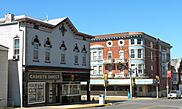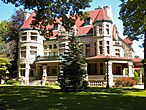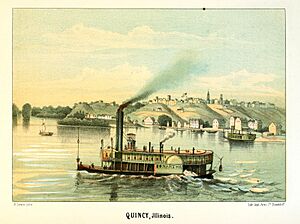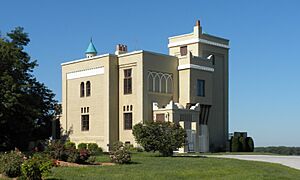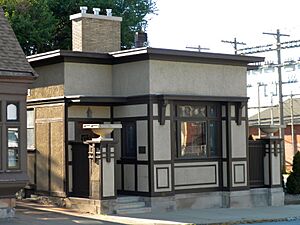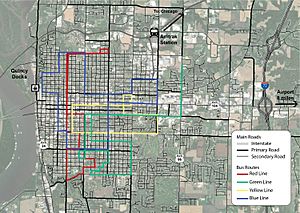Quincy, Illinois facts for kids
Quick facts for kids
Quincy, Illinois
|
||
|---|---|---|
| City of Quincy | ||
|
|
||
|
||
| Nickname(s):
Gem City
|
||
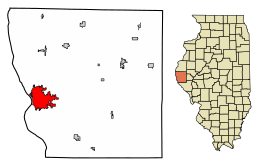
Location of Quincy in Adams County, Illinois.
|
||
| Country | United States | |
| State | Illinois | |
| County | Adams | |
| Government | ||
| • Type | Mayor–council | |
| Area | ||
| • City | 15.81 sq mi (40.94 km2) | |
| • Land | 15.77 sq mi (40.83 km2) | |
| • Water | 0.04 sq mi (0.11 km2) | |
| Elevation | 633 ft (193 m) | |
| Population
(2020)
|
||
| • City | 39,463 | |
| • Density | 2,503.20/sq mi (966.50/km2) | |
| • Metro | 75,546 | |
| Time zone | UTC−6 (CST) | |
| • Summer (DST) | UTC−5 (CDT) | |
| ZIP codes |
62301, 62305, 62306
|
|
| Area codes | 217, 447 | |
| FIPS code | 17-001-62380 | |
| GNIS feature ID | 2396301 | |
Quincy (/ˈkwɪnsi/ KWIN-see) is a city in Adams County, Illinois, United States. It's located right on the Mississippi River. In 2020, about 39,463 people lived there.
Quincy is often called Illinois's "Gem City." It was a very busy place for travel in the 1800s. Riverboats and trains connected the city to many places. It even became Illinois' second-largest city in 1870. Quincy has cool historic areas, like the Downtown Quincy Historic District and the South Side German Historic District. These areas show off the amazing buildings built by German immigrants long ago.
Contents
- Exploring Quincy's Past: A Look at Its History
- Quincy's Location and Surroundings
- People and Population in Quincy
- Quincy's Economy and Jobs
- Arts, Culture, and Fun in Quincy
- Parks and Outdoor Fun in Quincy
- Learning and Education in Quincy
- Media and News in Quincy
- Getting Around Quincy: Transportation
- Famous People from Quincy
- Quincy's Sister Cities
- Images for kids
- See also
Exploring Quincy's Past: A Look at Its History
Early Days Along the Mississippi River
Quincy's spot by the Mississippi River has always attracted people. The French were the first Europeans to explore this area. They came after explorers like Louis Jolliet and Jacques Marquette traveled the Upper Mississippi River Valley. Trading furs was a big deal back then. The Mississippi River was like a superhighway for moving goods.
After a big war called the Seven Years' War ended in 1763, Great Britain took over this land. Later, after the American Revolutionary War, the area became part of the United States. It officially became part of the State of Illinois in 1818.
The 1800s: Growth and Important Events
After the War of 1812, the U.S. government gave land to soldiers. This helped more people move west. A man named John Wood bought 160 acres (about 0.65 square kilometers) of this land in 1819. He later founded Quincy, which was first called Bluffs, Illinois.
In 1825, Bluffs changed its name to Quincy. It became the main town for Adams County. Both were named after the new U.S. President, John Quincy Adams. Quincy became an official city in 1840, and Ebenezer Moore was its first mayor.
In 1837, many members of the Church of Jesus Christ of Latter-day Saints (Mormons) had to leave Missouri. They found safety in Quincy. Even though there were many more Mormon refugees than Quincy residents, the people of Quincy helped them with food and places to stay. Later, Joseph Smith led the Mormons to Nauvoo, Illinois. In 1838, Quincy also helped the Pottawatomie tribe when they were forced to move from Indiana to Kansas.
The 1850s and 1860s were great years for Quincy. Steamboats and railroads connected Quincy to places further west. This made the city a popular stop for immigrants. The Chicago, Burlington and Quincy Railroad started in 1855. Building the Quincy Rail Bridge also helped Quincy become a major transportation center. The city grew a lot during this time. Its population jumped from 7,000 in 1850 to 24,000 by 1870. This made Quincy the second-largest city in Illinois.
A famous person who lived in Quincy was George E. Pickett. He later became a Confederate general. As a young man in the 1840s, he came to Quincy to study law with his uncle. His uncle knew Abraham Lincoln, so Pickett and Lincoln might have even met in Quincy.
In 1860, Quincy's founder, John Wood, became the governor of Illinois. He was busy building his mansion in Quincy. The state allowed him to stay in Quincy while he was governor. This meant Quincy was like a "second" state capital for a while. His absence from the official governor's office in Springfield gave Abraham Lincoln a place to plan his presidential campaign.
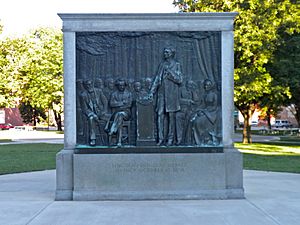
Slavery was a very important issue in Quincy's early years. Quincy was right across the Mississippi River from Missouri, which was a slave state. This made Quincy a hot spot for debates about slavery. Richard Eells, who was against slavery, built his home in Quincy in 1835. He helped enslaved people who had escaped on their way to Chicago. His home was a major stop on the Underground Railroad. The disagreements over slavery reached a peak in 1858. Quincy hosted the sixth debate between U.S. Senator Stephen A. Douglas and his opponent, Abraham Lincoln. About 12,000 people came to watch. Quincy was the biggest place where Lincoln and Douglas debated.
Lincoln and Douglas faced each other again in the 1860 Presidential election. This campaign also divided Quincy. Lincoln's supporters, called the Wide Awakes, marched to a rally in Plainville. On their way back to Quincy, Douglas's supporters shot at them. This led to a fight known as the Stone Prairie Riots.
The Civil War brought more growth to Quincy. Even though battles were far away, Quincy was a place where many Illinois volunteer army groups were formed. After the war, Quincy was chosen for Illinois' first Veteran's Home in 1886.
Immigrants Make Quincy Their Home
Early immigrants to Quincy mostly came from New England. They were looking for better land. They brought ideas like public education and being against slavery. Starting in the 1840s, many people from Germany moved to Quincy. They were escaping problems in their home country. German immigrants often lived close to each other, especially in the southern part of the city. They greatly influenced Quincy's historic buildings. This area became known as Calftown because almost every house had a cow!
In 1860, a group of Franciscan friars started the St. Francis Solanus College. This college later became Quincy University.
Quincy in the 1900s and 2000s
Quincy grew from a small river town to an important city and port in the 1800s. Train and steamboat activity continued to boom. Many of the city's historic buildings in the Downtown Quincy Historic District were built in the early 1900s. This included Quincy's first skyscraper, the Western Catholic Union Building, in 1925.
As cars became more popular, Quincy needed new ways to cross the Mississippi River. Before cars, people used boats or ferries. In 1928, work began on the Quincy Memorial Bridge. This two-lane bridge opened in May 1930. By 1945, the city had paid off its loans and removed the toll.
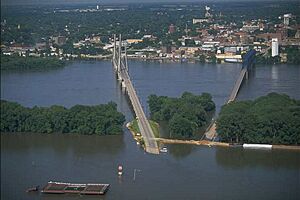
On April 12, 1945, a tornado hit Quincy's business area. It badly damaged the courthouse. The wind was so strong it blew the roof off! A new courthouse was built five years later.
In 1987, the Bayview Bridge was built. This bridge helped reduce traffic on the older Memorial Bridge. Today, the Bayview Bridge carries westbound traffic, and the Memorial Bridge carries eastbound traffic.
During the Great Flood of 1993 on the Mississippi River, many businesses by the river were damaged. The river reached a record high of 32.2 feet (9.81 meters). For a while, the Bayview Bridge was the only bridge open across the Mississippi River in a large area. Both of Quincy's bridges reopened 73 days later.
On November 19, 1996, a plane crash happened at Quincy Regional Airport. A United Express flight collided with a private plane. All 14 people on both planes died.
In June 2008, another flood covered much of Quincy's riverfront. The Mississippi River reached record levels again.
Quincy has been named an All-America City twice. It's also part of the Tree City USA program. In 2010, Forbes Magazine listed Quincy as the eighth "Best Small City To Raise A Family."
Quincy's Location and Surroundings
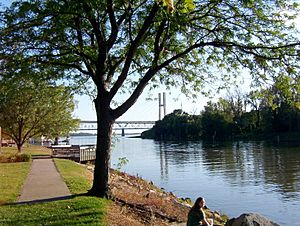
Quincy is located at 39°55′56″N 91°23′19″W / 39.93222°N 91.38861°W. It's right next to the Mississippi River and Quincy Bay. The city covers about 15.81 square miles (40.94 square kilometers). Most of this area is land.
The city sits on high ground called bluffs, which overlook the Mississippi River. Across the river in Missouri is West Quincy. This area is mostly flat farmland. East of Quincy are the Quincy Hills, with rolling hills, woods, and farms. Flat prairie land is to the north.
Quincy is the biggest city and main center of the Tri-State region. This region includes western Illinois, northeastern Missouri, and southeastern Iowa.
Weather in Quincy
| Climate data for Quincy, Illinois (Lock and Dam No. 21) (1991–2020 normals, extremes 1901–present) | |||||||||||||
|---|---|---|---|---|---|---|---|---|---|---|---|---|---|
| Month | Jan | Feb | Mar | Apr | May | Jun | Jul | Aug | Sep | Oct | Nov | Dec | Year |
| Record high °F (°C) | 79 (26) |
80 (27) |
88 (31) |
92 (33) |
103 (39) |
105 (41) |
114 (46) |
111 (44) |
105 (41) |
97 (36) |
87 (31) |
76 (24) |
114 (46) |
| Mean maximum °F (°C) | 59.6 (15.3) |
64.6 (18.1) |
74.2 (23.4) |
83.6 (28.7) |
88.5 (31.4) |
93.9 (34.4) |
97.1 (36.2) |
97.3 (36.3) |
92.5 (33.6) |
85.9 (29.9) |
73.3 (22.9) |
62.9 (17.2) |
99.4 (37.4) |
| Mean daily maximum °F (°C) | 35.1 (1.7) |
40.4 (4.7) |
51.8 (11.0) |
64.4 (18.0) |
74.1 (23.4) |
83.4 (28.6) |
87.2 (30.7) |
85.6 (29.8) |
78.9 (26.1) |
66.6 (19.2) |
52.5 (11.4) |
40.2 (4.6) |
63.3 (17.4) |
| Daily mean °F (°C) | 27.0 (−2.8) |
31.6 (−0.2) |
41.9 (5.5) |
53.6 (12.0) |
64.1 (17.8) |
73.6 (23.1) |
77.4 (25.2) |
75.7 (24.3) |
68.0 (20.0) |
56.0 (13.3) |
43.2 (6.2) |
32.3 (0.2) |
53.7 (12.1) |
| Mean daily minimum °F (°C) | 18.9 (−7.3) |
22.7 (−5.2) |
32.0 (0.0) |
42.9 (6.1) |
54.2 (12.3) |
63.9 (17.7) |
67.6 (19.8) |
65.7 (18.7) |
57.1 (13.9) |
45.4 (7.4) |
33.8 (1.0) |
24.5 (−4.2) |
44.1 (6.7) |
| Mean minimum °F (°C) | −1.5 (−18.6) |
4.1 (−15.5) |
13.6 (−10.2) |
29.1 (−1.6) |
41.4 (5.2) |
53.3 (11.8) |
58.8 (14.9) |
57.6 (14.2) |
43.7 (6.5) |
31.0 (−0.6) |
18.4 (−7.6) |
6.2 (−14.3) |
−5.0 (−20.6) |
| Record low °F (°C) | −21 (−29) |
−29 (−34) |
−12 (−24) |
12 (−11) |
26 (−3) |
39 (4) |
48 (9) |
44 (7) |
26 (−3) |
10 (−12) |
−3 (−19) |
−20 (−29) |
−29 (−34) |
| Average precipitation inches (mm) | 1.66 (42) |
1.91 (49) |
2.48 (63) |
4.22 (107) |
4.80 (122) |
4.12 (105) |
3.64 (92) |
3.33 (85) |
3.37 (86) |
2.65 (67) |
2.57 (65) |
1.73 (44) |
36.48 (927) |
| Average precipitation days (≥ 0.01 in) | 7.2 | 6.6 | 9.1 | 10.5 | 10.6 | 9.3 | 8.2 | 7.0 | 6.2 | 8.2 | 7.3 | 6.9 | 97.1 |
| Source: NOAA | |||||||||||||
People and Population in Quincy
| Historical population | |||
|---|---|---|---|
| Census | Pop. | %± | |
| 1840 | 2,319 | — | |
| 1850 | 6,902 | 197.6% | |
| 1860 | 13,718 | 98.8% | |
| 1870 | 24,052 | 75.3% | |
| 1880 | 27,268 | 13.4% | |
| 1890 | 31,494 | 15.5% | |
| 1900 | 36,252 | 15.1% | |
| 1910 | 36,587 | 0.9% | |
| 1920 | 35,978 | −1.7% | |
| 1930 | 39,241 | 9.1% | |
| 1940 | 40,469 | 3.1% | |
| 1950 | 41,450 | 2.4% | |
| 1960 | 43,793 | 5.7% | |
| 1970 | 45,288 | 3.4% | |
| 1980 | 42,554 | −6.0% | |
| 1990 | 39,681 | −6.8% | |
| 2000 | 40,366 | 1.7% | |
| 2010 | 40,633 | 0.7% | |
| 2020 | 39,463 | −2.9% | |
| U.S. Decennial Census | |||
In 2020, Quincy had 39,463 people living in 17,226 households. About 25.3% of these households had children under 18. Most people in Quincy are White (86.3%). There are also African American (5.87%), Asian (1.01%), and other groups. About 2.33% of the population is Hispanic or Latino.
The average age in Quincy is 40.3 years old. The city's income for a household was about $46,935. For families, it was about $64,891.
Quincy's Economy and Jobs
Many companies are based in Quincy, like Niemann Foods, Gardner Denver, and The Knapheide Manufacturing Company. Big employers in the area include Blessing Hospital, Quincy Public Schools, and Titan Wheel.
In 1978, Quincy started the Great River Economic Development Foundation. This group helps keep businesses in the area and attract new ones. Quincy is seen as an important region in the Midwest.
Living in Quincy is generally cheaper than the national average. This includes costs for food and utilities. In 2010, Forbes Magazine ranked Quincy as the eighth "Best Small City To Raise A Family." They looked at things like commute times, high school graduation rates, and home ownership.
Arts, Culture, and Fun in Quincy
Quincy has a mix of Midwestern culture. It's also a city that loves the arts. It's home to America's first Arts Council, the Quincy Society of Fine Arts, started in 1947. Many art groups offer entertainment, workshops, and festivals. Quincy was even named one of "America's Most Artistic Towns" by Expedia in 2017 and 2018.
The Dogwood Parade and festival happens every May. It celebrates the blooming Dogwood trees. Washington Park is a busy spot for fun events like farmer's markets and the Q-Fest.
The Historical Society of Quincy and Adams County hosts events at the History Museum and the John Wood Mansion. The Quincy Community Theatre has been putting on shows for over 80 years! The Quincy Art Center and Quincy Museum also have an annual Art Fest.
Quincy's riverfront is great for activities all year. You can watch Fourth of July fireworks or outdoor movies. The Villa Kathrine, a unique building, is the visitor's center. It gives information about Quincy and the area.
The Historic Downtown District is a popular place for dining, entertainment, and shopping. It mixes old buildings with modern shops. The Quincy Area Chamber of Commerce helps businesses in the area.
The Quincy YMCA and The Salvation Army Kroc Center offer fitness and recreation. The Quincy Park District has many parks, trails, and programs.
Quincy's Amazing Architecture
Quincy has many different and interesting buildings. South of downtown is the South Side German Historic District. Here you'll find many buildings built by early German immigrants. The Dick Brothers Brewery buildings are a central site. They were built in 1857 and were once very large breweries.
Other areas like Maine Street and the East End also show Quincy's rich building history. Many homes here are in the Victorian style. The Newcomb residence is now the Quincy Museum. It was even featured on the cover of National Geographic for its important architecture.
Quincy also has buildings with a Mediterranean style, like the Villa Kathrine and B'nai Sholom Temple. The Villa Kathrine was designed in a Moroccan style in 1900. Today, it's the visitor's center.
Parks and Outdoor Fun in Quincy
The Quincy Park District manages over 1,000 acres (about 4 square kilometers) of land. This is divided into 26 parks! Some popular parks include All-American Park, Bob Mays Park, and Washington Park. Washington Park was Quincy's first park and was a site for the Lincoln-Douglas debates.
Quinsippi Island is a large island park. Bob Mays Park opened in 2008. Indian Mounds Park had the first public swimming pool. Moorman Park has baseball and softball fields, a batting cage, and mini-golf. Reservoir Park has tennis courts for tournaments.
Learning and Education in Quincy
Quincy has several schools and colleges. Quincy Senior High School is on Maine Street. Quincy Notre Dame High School is a private Catholic high school. Quincy University was founded in the 1860s. John Wood Community College is on the east side of the city. Gem City College and Blessing-Rieman College of Nursing are also in Quincy.
Other colleges nearby include Western Illinois University in Macomb, Hannibal-LaGrange College in Hannibal, Missouri, and Culver-Stockton College in Canton, Missouri.
Media and News in Quincy
Quincy's television market includes Quincy, Hannibal, Macomb, and Keokuk. You can get cable TV from Comcast or satellite TV from DirecTV or Dish.
Quincy and Hannibal are often grouped together as a media market. You can watch channels like ABC, CBS, NBC, Fox, and CW. Many local media outlets are owned by STARadio Corporation and Quincy Media. Quincy also has many radio stations.
Getting Around Quincy: Transportation
Highways and Roads
Interstate 72 is about 12 miles (19 kilometers) south of Quincy. Its smaller route, Interstate 172, is just east of town. Illinois Route 104 (Broadway) is a main road that goes from the Mississippi River bridges to Interstate 172. Illinois Route 96 enters the city from the southeast and also serves as the Great River Road.
Eastbound traffic crosses the Mississippi River on the Quincy Memorial Bridge. Westbound traffic uses the newer Bayview Bridge. On the Missouri side, U.S. 61 is a four-lane highway called the Avenue of the Saints. This highway connects Saint Louis to Minneapolis–Saint Paul.
Quincy is connected by four-lane highways in all directions:
- The Avenue of the Saints is just five miles west.
- Illinois Highway 172 is part of the new Route 110/CKC (Chicago–Kansas City Expressway).
Air Travel
The Quincy Regional Airport is about 5 miles (8 kilometers) east of the city. Cape Air has daily flights to Chicago-O'Hare and St. Louis-Lambert airports. You can also get flight lessons and rent planes at the airport.
Train Travel
Quincy has an Amtrak train station on the north side of town. Two trains, the Illinois Zephyr and the Carl Sandburg, connect Quincy to Chicago. Chicago is Amtrak's main hub, so you can connect to many other cities from there.
River Transport
Quincy has the northernmost port on the Mississippi River that can be used by barges all year. The city's barge dock helps many industries.
Public Buses
Quincy Transit Lines provides bus service around Quincy. There are four main bus routes that run Monday through Saturday. On Sundays and holidays, there are two routes.
Famous People from Quincy
- Mary Astor, an actress who won an Academy Award
- Avenue Beat, a pop/R&B music group
- Caren Kemner, an Olympic volleyball player
- Arthur Pitney, who invented the postage meter
- Rick Reuschel, a Major League Baseball player
- Paul Tibbets, the pilot who flew the Enola Gay
- Augustus Tolton, the first recognized African-American Roman Catholic priest in the U.S.
- Jonathan Van Ness, a hairstylist and TV personality from Queer Eye
- Elmer H. Wavering, a president of Motorola and inventor of the car radio
- John Wood, the 12th Governor of Illinois
- James Scott, known for his role in the Great Flood of 1993
Quincy's Sister Cities
Quincy, Illinois, has two sister cities:
Images for kids
See also
 In Spanish: Quincy (Illinois) para niños
In Spanish: Quincy (Illinois) para niños



